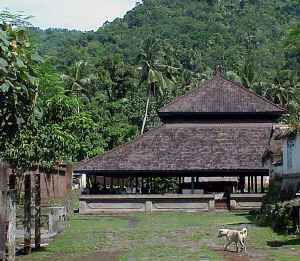|
| |
[ Up ] [ HOME ]
[ Cast System ] [ Cremation ] [ Music and Dance ] [ Religion ] [ Rites of Passage ] [ Special Days ] [ The Home ] [ Way of Life ]
The Banjar and the caste system
Balinese people live under two bonds. The
first is determined by descent and caste.
The second is determined democratically by his village and Banjar
organization.
|

This is a picture of a Bali Banjar Pavilion in Tenganan an ancient
Bali Aga village in East Bali
|
In the center of every Banjar stands a Bale Banjar or Banjar pavilion.
Meetings are held here, village feasts are prepared and the people gather
here at night to play cards or just talk. The
communal work is administered from the Bale Banjar.
This work consists of repairing roads, bridges and irrigation canals, the
upkeep of the temples, and preparations for cockfights and celebrations.
Many villagers spend more time on the Banjar pavilion than
they do at home. The Balinese love to be with people and with their
family and friends for this reason they will do most things in pairs or groups.
The bamboo platforms in the Bale Banjar become long beds at night where
villagers often sleep, in the company of their fellow man.
The Banjar is the core of village life.
It runs its own affairs as a community of equals.
The same principle applies to other communal organizations, such as the
local dance group or rice-field association.
|
Balinese life also deals with the existence of a caste system. Most of Bali's
population, approximately 75-90%, belong to the Sudra "Wong Kesamen" caste. It
is the remaining population that make up the Tri-Wangsa, the higher cast. Before
the Banjar all are equal regardless of caste. Outside
the Banjar the Tri-Wangsa are held in great respect and are spoken to in a
different more refined language than that used in everyday speech on the roads
or in the market.
Most members of the Tri-Wangsa caste are
the descendants of the Javanese conquerors of Bali in the 14th
century, or exiles from the spread of Islam in Java in the 15th and
16th centuries. The Brahmanas (with the title Ida
Bagus) are the religious, political, and
princely caste. The Ksatriyasa (or Satriana) are the merchants and make up
the second caste. The Waisya (or Gusti), is the administrative and warrior cast.
In the past the
members of these
castes only married within their own caste, but this convention is no longer
strictly adhered to.
Language is complex matter in Bali; basically there are two different
Balinese languages. The common or low language of the sutras is of Austronesian
(Polynesian) derivation. The high
language of the Triwangsa is a Javanese court language.
A sutra should use the high language when speaking to a member of a
higher caste, and he should be replied to in the low language.
To cover the embarrassment that sometimes emerges, a polite, “middle”
language is used. Now a fourth language, the state language Bahasa Indonesia is
taught in the schools as a unifier for the modern Indonesian Republic.
Within the philosophy of Balinese religion are the concepts of “Buwana
Alit Buwana Agung”, the microcosm and the society are large: the one cannot
exist without the other and they are, because of this, the same.
Over the centuries the Balinese have had a strong sense of culture and an
orderly and humane society. They
had assimilated two periods of influence from Java.
Now they face the influence of mass tourism and technology.
Hopefully, the village structure and religion that has guided them so far
will remain strong and alive.
[ Next ]
[ Cast System ] [ Cremation ] [ Music and Dance ] [ Religion ] [ Rites of Passage ] [ Special Days ] [ The Home ] [ Way of Life ] |